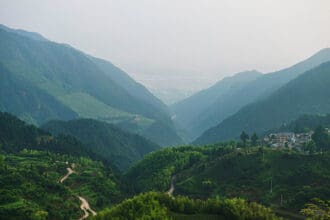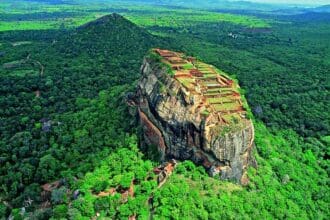Manikaran, nestled in the breathtaking Parvati Valley of Himachal Pradesh (Places to Visit in Manikaran), is a destination that captivates travelers with its serene landscapes, spiritual aura, and rich cultural heritage. Known for its natural hot springs, ancient temples, and lush greenery, this quaint town offers an unforgettable experience for those seeking peace, adventure, or a deeper connection with nature. In this article, we will explore the top 5 places to visit in Manikaran , uncovering their unique charm, historical significance, and hidden gems. Whether you’re a solo traveler, a family on vacation, or a spiritual seeker, Manikaran has something special for everyone.
1. Manikaran Sahib Gurudwara: A Spiritual Haven
The Manikaran Sahib Gurudwara is undoubtedly the crown jewel of this picturesque town. Revered by Sikhs and people of all faiths, this sacred shrine holds immense religious significance. According to legend, Guru Nanak Dev Ji, the founder of Sikhism, visited Manikaran during his travels and performed miracles here. The gurudwara stands as a testament to the divine presence and serves as a beacon of spirituality for pilgrims worldwide.
History and Significance
The origins of the Manikaran Sahib Gurudwara are steeped in fascinating tales. It is believed that Guru Nanak Dev Ji, along with his companion Bhai Mardana, stopped at Manikaran during their journey. When Bhai Mardana lost his precious ornament (mani) in the river, Guru Nanak miraculously retrieved it, giving the place its name—”Manikaran,” meaning “jewel” and “earring.” This story adds a mystical allure to the gurudwara, drawing devotees who seek blessings and solace.
The gurudwara’s history dates back several centuries, making it a revered site for Sikh pilgrims. Over time, it has evolved into a symbol of communal harmony, attracting visitors from diverse backgrounds. People from all walks of life come here to experience the divine energy and partake in the langar (community kitchen), which operates round the clock.
Architectural Marvel
The gurudwara’s architecture is a blend of traditional Sikh design and local Himalayan influences. Its pristine white facade, intricate carvings, and golden domes create a mesmerizing sight against the backdrop of snow-capped mountains. Inside, the serene ambiance and melodious kirtans (devotional songs) transport visitors to a state of tranquility.
The main prayer hall is adorned with colorful frescoes depicting scenes from Sikh history and mythology. The marble flooring and ornate pillars add to the grandeur of the space. Outside, the sprawling courtyard provides ample seating for devotees and tourists alike, offering panoramic views of the surrounding valley.
Natural Hot Springs
One of the most remarkable features of the Manikaran Sahib Gurudwara is its natural hot springs . These geothermal springs are considered sacred and are believed to have healing properties. Pilgrims and tourists alike bathe in these warm waters, which are said to cure ailments such as arthritis and skin conditions. The hot springs also serve langar (community kitchen) purposes, where food is cooked using the steam from the springs—a unique and eco-friendly practice.
There are separate bathing areas for men and women, ensuring privacy and comfort. The water temperature varies slightly depending on the season, but it remains consistently warm throughout the year. Many visitors spend hours soaking in the therapeutic waters, feeling rejuvenated both physically and spiritually.
Travel Tips
- Best Time to Visit: October to June is ideal, as the weather remains pleasant.
- Dress Code: Modest clothing is recommended; headscarves are provided for women entering the gurudwara.
- Nearby Attractions: Kasol, Kheerganga Trek, and Tosh Village.
“The Manikaran Sahib Gurudwara is not just a place of worship but a sanctuary for the soul, where divinity meets nature.”
2. Kheerganga Trek: An Adventurer’s Paradise
For adventure enthusiasts and nature lovers, the Kheerganga Trek is a must-do activity when visiting Manikaran. This moderate trek takes you through dense forests, cascading waterfalls, and panoramic vistas, culminating in the stunning Kheerganga meadow. Perched at an altitude of approximately 3,050 meters, Kheerganga offers breathtaking views of the surrounding peaks and valleys.
The Trekking Experience
The journey begins from Barshain village, located about 6 kilometers from Manikaran. As you ascend, the trail becomes increasingly enchanting, with towering pine trees, vibrant rhododendrons, and the soothing sound of gushing streams accompanying you every step of the way. Along the route, you’ll encounter several small waterfalls, adding to the trek’s charm.
Upon reaching Kheerganga, you’ll be greeted by a serene meadow adorned with wildflowers and a natural hot water pool . Legend has it that Lord Shiva and Goddess Parvati once meditated here, making the site spiritually significant. Trekkers often take a dip in the warm waters to rejuvenate their bodies after the challenging climb.
The trek is approximately 14 kilometers round trip and typically takes 6-8 hours to complete. While it is moderately challenging, even beginners can undertake it with proper preparation and guidance. The trail is well-marked, and local guides are available for hire if needed.
Camping Under the Stars
Kheerganga is a popular camping destination, offering an unparalleled experience of sleeping under a blanket of stars. Numerous tents and basic accommodation options are available, allowing trekkers to spend the night amidst nature’s splendor. The crisp mountain air and the distant hum of cicadas make for a truly magical evening.
Campfires are organized by local operators, providing warmth and entertainment during chilly nights. You can enjoy storytelling sessions, music performances, and stargazing while sipping on hot cups of tea or coffee. For many, camping at Kheerganga is the highlight of their trip to Manikaran.
Travel Tips
- Fitness Level Required: Moderate; suitable for beginners with some prior trekking experience.
- What to Carry: Comfortable trekking shoes, warm clothing, snacks, and a first-aid kit.
- Nearby Attractions: Rudra Nag Waterfall, Tosh Village, and Pin Parvati Pass.
“Kheerganga is more than a trek—it’s a journey into the heart of the Himalayas, where adventure meets serenity.”
3. Rudra Nag Waterfall: Nature’s Masterpiece
Nestled amidst verdant forests, the Rudra Nag Waterfall is another gem in Manikaran’s treasure trove. Located approximately 4 kilometers from the main town, this majestic waterfall cascades down rocky cliffs, creating a mesmerizing spectacle. Named after Lord Shiva (Rudra), the waterfall is believed to possess divine energy, attracting both pilgrims and nature enthusiasts.
Exploring the Trail
To reach Rudra Nag, visitors must embark on a short yet scenic hike through dense woods. The trail is dotted with vibrant flora and fauna, making it a delight for photography enthusiasts. Along the way, you’ll find small shrines dedicated to Lord Shiva, adding a spiritual dimension to your exploration.
As you approach the waterfall, the sound of rushing water grows louder, building anticipation for the grand reveal. Standing before Rudra Nag, you’ll feel dwarfed by its sheer magnitude and raw power. The mist created by the falling water refreshes your senses, while the cool breeze provides respite from the summer heat.
The waterfall is particularly striking during the monsoon season when the volume of water increases significantly. However, it remains accessible year-round, offering a refreshing escape regardless of the season.
Mythological Significance
According to Hindu mythology, Rudra Nag is one of the 108 sacred sites associated with Lord Shiva. It is believed that performing rituals here can cleanse sins and bring prosperity. Many devotees visit the waterfall during festivals like Maha Shivaratri to offer prayers and seek blessings.
Local legends also speak of hidden treasures buried beneath the waterfall, guarded by supernatural forces. While these stories may be mythical, they add an element of intrigue and wonder to the site.
Travel Tips
- Best Time to Visit: April to September, when the weather is mild and the waterfall flows abundantly.
- What to Bring: Waterproof gear, sturdy shoes, and a camera to capture the beauty.
- Nearby Attractions: Manikaran Sahib Gurudwara, Kasol Market, and Parvati River.
“Rudra Nag Waterfall is a testament to nature’s artistry, where myth and reality converge in perfect harmony.”
4. Parvati River: The Lifeline of Manikaran
Flowing gracefully through the Parvati Valley, the Parvati River is the lifeline of Manikaran. Its crystal-clear waters and tranquil banks provide a perfect setting for relaxation and introspection. Whether you’re looking to unwind by the riverside or engage in thrilling water sports, the Parvati River promises an unforgettable experience.
Activities by the River
The Parvati River offers a range of activities for visitors of all ages. Adventure seekers can try their hand at river rafting , navigating the rapids while enjoying the stunning scenery. For those seeking a more laid-back experience, picnicking by the riverbank or simply dipping your feet in the cool water can be incredibly refreshing.
Photography enthusiasts will find endless opportunities to capture the river’s ethereal beauty. The interplay of sunlight on the water, coupled with the lush greenery surrounding it, creates a picturesque setting that begs to be immortalized.
During the summer months, locals and tourists gather along the riverbanks to celebrate festivals and organize cultural events. These gatherings foster a sense of community and allow visitors to immerse themselves in the region’s vibrant traditions.
Spiritual Connection
The Parvati River holds deep spiritual significance, particularly among followers of Hinduism. It is named after Goddess Parvati, the consort of Lord Shiva, and is considered sacred. Many locals perform rituals and ceremonies along its banks, believing that the river possesses purifying powers.
The river is also a source of sustenance for nearby villages, supporting agriculture and providing drinking water. Its importance extends beyond religion, playing a vital role in the daily lives of residents.
Travel Tips
- Safety Precautions: Always wear life jackets while participating in water activities.
- Best Time to Visit: March to October, when the river levels are optimal for recreation.
- Nearby Attractions: Manikaran Sahib Gurudwara, Kheerganga Trek, and Tosh Village.
“The Parvati River is not just a geographical feature but a symbol of life, spirituality, and timeless beauty.”
5. Tosh Village: A Hidden Gem
Located about 20 kilometers from Manikaran, Tosh Village is a secluded paradise that offers a glimpse into the rustic charm of Himachal Pradesh. Surrounded by towering mountains and lush apple orchards, this quaint village exudes tranquility and simplicity. It is an ideal destination for those seeking solitude and a break from urban chaos.
Village Life
Life in Tosh revolves around agriculture and tourism. The villagers are warm and welcoming, eager to share their culture and traditions with visitors. You can interact with locals, learn about their daily routines, and even participate in farming activities if you wish.
The village is dotted with cozy homestays and cafes, many of which are run by Israeli expats who have made Tosh their home. These establishments offer delicious meals, ranging from local Himachali delicacies to international cuisines, ensuring there’s something for every palate.
Visitors can also purchase handmade crafts and souvenirs directly from artisans, supporting the local economy. From intricately woven shawls to wooden carvings, each item reflects the skill and creativity of the artisans.
Scenic Beauty
Tosh’s natural beauty is unparalleled. Rolling hills covered in deodar trees, terraced fields, and colorful prayer flags fluttering in the wind create a postcard-perfect setting. The village also serves as a base camp for treks to destinations like Kheerganga and Pin Parvati Pass, making it a favorite among adventurers.
Sunrise and sunset views from Tosh are particularly breathtaking, with the sky painted in hues of orange, pink, and purple. Many visitors wake up early to witness this natural spectacle, capturing memories that last a lifetime.
Travel Tips – Places to Visit in Manikaran
- How to Reach: Hire a taxi or shared cab from Manikaran; private vehicles are advisable due to narrow roads.
- Best Time to Visit: May to October, when the weather is pleasant and the trails are accessible.
- Nearby Attractions: Malana Village, Kasol, and Manikaran Sahib Gurudwara.
“Tosh Village is a slice of heaven on earth, where simplicity meets splendor in the lap of nature.”
Travel Tips for Exploring Manikaran – Places to Visit in Manikaran
- Plan Ahead: Research accommodations and transportation options in advance, especially during peak tourist seasons.
- Respect Local Customs: Dress modestly and adhere to local traditions, particularly when visiting religious sites.
- Stay Hydrated: Carry sufficient water, as high-altitude areas can cause dehydration.
- Pack Essentials: Include sunscreen, sunglasses, and a hat to protect yourself from the sun.
- Hire Guides: Consider hiring local guides for treks and tours to ensure safety and gain insights into the region’s history.
- Carry Cash: ATMs are scarce in remote areas; carry enough cash for expenses.
- Check Weather Conditions: Be prepared for sudden changes in weather, especially during treks.
- Respect Wildlife: Avoid disturbing animals and plants; follow eco-friendly practices.
- Book Accommodations Early: Popular spots fill up quickly, especially during holidays and festivals.
- Stay Connected: Ensure your phone has network coverage or carry a portable Wi-Fi device.
Nearby Hotels and Restaurants – Places to Visit in Manikaran
Hotels
- Hotel Rudra Continental: Offers comfortable rooms with modern amenities and stunning valley views. Ideal for families and couples seeking luxury.
- Apple Orchard Resort: A boutique property surrounded by apple orchards, perfect for a peaceful stay. Features an on-site restaurant and spa facilities.
- Parvati Valley Homestay: Provides an authentic village experience with home-cooked meals. Great for budget travelers and solo adventurers.
Restaurants
- Everest Cafe: Known for its Israeli dishes and cozy ambiance. A favorite among backpackers and long-term travelers.
- Shiva Cafe: Serves delicious Indian and continental cuisine with panoramic views of the valley. Offers vegetarian and vegan options.
- German Bakery: A popular spot for freshly baked goods and coffee. Perfect for breakfast or a quick snack.
Conclusion
Manikaran is a destination that effortlessly blends spirituality, adventure, and natural beauty. From the divine aura of the Manikaran Sahib Gurudwara to the adrenaline-pumping Kheerganga Trek , each attraction offers a unique experience that leaves a lasting impression. Whether you’re soaking in the therapeutic waters of the hot springs, marveling at the majesty of Rudra Nag Waterfall , or exploring the serene charm of Tosh Village , Manikaran promises memories that will linger long after your journey ends.
This enchanting town invites you to slow down, connect with nature, and rediscover the simple joys of life. Whether you’re a seasoned traveler or embarking on your first adventure, Manikaran welcomes you with open arms and endless possibilities.
10 FAQs About Manikaran
- What is the best time to visit Manikaran?
- The best time to visit is between October and June when the weather is pleasant.
- Is Manikaran suitable for families?
- Yes, it offers activities and attractions for all age groups.
- How do I reach Manikaran?
- By road via Bhuntar or Kullu; nearest airport is Bhuntar Airport.
- Are the hot springs safe for bathing?
- Yes, they are safe and believed to have healing properties.
- What should I pack for the Kheerganga Trek?
- Trekking shoes, warm clothes, snacks, and a first-aid kit.
- Can I visit Rudra Nag Waterfall in winter?
- It’s accessible, but the trail may be slippery due to snow.
- Is Manikaran pet-friendly?
- Some accommodations allow pets; check beforehand.
- What languages are spoken in Manikaran?
- Hindi, English, and local dialects like Pahari.
- Are there ATMs in Manikaran?
- Limited; carry cash for convenience.
- What is the significance of the Parvati River?
- It is named after Goddess Parvati and holds spiritual importance.













